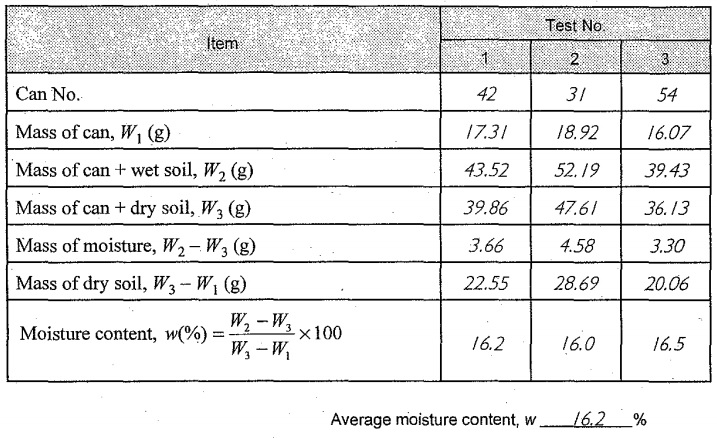Determination of Water Content
Courses > Soil Mechanics > Geotechnical Laboratory and In-Situ Testing Methods > Determination of Water Content Introduction
Introduction
Most laboratory tests in soil mechanics require the determination of water content. Water content is defined as
w = weight of water present in a given soil mass / weight of dry soil
Water content is usually expressed in percent.
For better results, the minimum size of the most soil specimens should be approximately as given in the table below. These values are consistent with ASTM Test Designation D-2216.
| Maximum Particle size in the soil (mm) | U.S. Sieve No. | Minimum Mass of soil sample (g) |
|---|---|---|
| 0.425 | 40 | 20 |
| 2.0 | 10 | 50 |
| 4.75 | 4 | 100 |
| 9.5 | 3/8 in | 500 |
| 19 | 3/4 in | 2500 |
 Concepts and Formulas
Concepts and Formulas
Equipment
1. Moisture can(s).
Moisture cans are available in various sizes [for example, 2-in. (50, S mm) diameter and % in. (22.2 mm) high, 3.5-in. (S8.9 mm) diameter and 2 in. (50.S mm) high).
2. Oven with temperature control.
For drying, the temperature of the oven is generally kept between 105°C to 110°C. A higher temperature should be avoided to prevent the burning of organic matter in the soil.
3. Balance.
The balance should have a readability of 0.01 g for specimens having amass of 200 g or less. If the specimen has a mass of over 200 g, the readability should be 0.1 g.
Procedure
1. Determine the mass (g) of the empty moisture can plus its cap (W1), and also record . the number.
2. Place a sample of representative moist soil in the can. Close the can with its cap to avoid loss of moisture.
3. Determine the combined mass (g) of the closed can and moist soil (W2).
4. Remove the cap from the top of the can and place it on the bottom (of the can).
5. Put the can (Step 4) in the oven to dry the soil to a constant weight. In most cases, 24 hours of drying is enough.
6. Determine the combined mass (g) of the dry soil sample plus the can and its cap (W3)
Calculation
1. Calculate the mass of moisture = W2 - W3
2. Calculate the mass of dry soil = W3 - W1
3. Calculate the water content w(%) = (W2 - W3) / (W3 - W1) * 100
Report the water content to the nearest 1% or 0.1% as appropriate based on the size of the specimen.
General Comments
a. Most natural soils, which are sandy and gravelly in nature, may have water contents up to about 15 to 20%. In natural fine-grained (silty or clayey) soils, water contents up to about 50 to 80% can be found. However, peat and highly organic soils with water contents up to about 500% are not uncommon. Typical values of water content for various types of natural soils in a saturated state are shown in the table below.
b. Some organic soils may decompose during oven drying at 110°C. An oven drying temperature of n 0° may be too high for soils containing gypsum, as this material slowly dehydrates. According to ASTM, 'a drying temperature of 60°C is more appropriate for such soils.
c. Cooling the dry soil after oven drying (Step 5) in a desiccator is recommended. It prevents absorption of moisture from the atmosphere.
| Soil | Natural water content in a saturated state (%) |
|---|---|
| loose uniform sand | 25-30 |
| dense uniform sand | 12-16 |
| Loose angular-grained silty sand | 25 |
| Dense angular-grained silty sand | 15 |
| Stiff clay | 20 |
| soft clay | 30-50 |
| Soft organic clay | 80-130 |
| Glacial till | 10 |
 Watch Videos
Watch Videos
 Solved sample problems
Solved sample problems

 Download Files
Download Files
 Read also
Read also
- Bituminous (Cementing) Stabilization
- Densities for Common Residential Construction Materials
- Solved Example: Design of a load-bearing brick (unreinforced masonry) wall (BS 5628)
- Soil Phase Relationships
- Effect of Ground Water Table
 Share
Share
Follow our official Facebook page (@civilengineeringbible) and Twitter page (@CivilEngBible) and do not miss the best civil engineering tools and articles!

